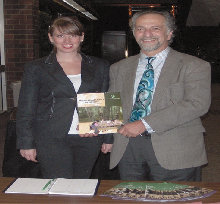Hagop Ohanessian
Staff Writer

Jeff Masarjian has been the executive director of the Armenian Tree Project since 1991 and on Tuesday, November 18, he gave an interesting lecture on “The Dangers Facing Armenia’s Natural Treasures: Current Risks and Opportunities,” as part of the Fall Lecture Series of the Armenian Studies Program.
According to the ATP 2007 Annual Report “The Armenian Tree project (ATP), a non-profit program based in Watertown, MA and Yerevan conducts vitally important environmental projects in Armenia’s impoverished and deforested zones and seeks to support in advancing its reforestation mission.” ATP was founded in 1994 and since then has made enormous efforts to prevent desertification that threatens the Caucasus region. Over the years, 2,000,000 trees have been planted and restored and jobs have been created for seasonal-tree related projects.
Masarjian has brought experience in clinical social work and organizational management in the non-profit sector to ATP. Over the past seven years, he has actively been involved in implementing three initiatives: planting trees at urban and rural sites, providing environmental education and advocacy, and community and socioeconomic development and poverty reduction. He often travels to Armenia to supervise the various projects and has traveled throughout the United States spreading awareness of ATP activities.
Masarjian used a power-point presentation to discuss the different projects that ATP is involved with in Armenia, in the areas of Teghut, Alaverdi, Aghtala, and near Lake Sevan. In Teghut, more than 12,000 square feet of forests have been cut to provide space for mining copper and molybdenum. The resulting open pits are violating environmental laws. In 2001, in the city of Alaverdi, twenty-one birth defects were reported due to hazardous toxic dumps in the area, a result of the unsupervised mining industry in the area.
Lake Sevan has also been impacted because of hazardous toxic waste. There are few trees that surround the lake and runoff from agricultural fertilizer and occasionally raw sewage have also been dumped into the lake. There is now a need to raise the water level in the lake, so that these wastes can be filtered and cleaned.
There have been numerous positive accomplishments in Armenia for ATP, such as new forestry preservation laws, developed in cooperation with the government. The Prime Minister of Armenia, Tigran Sargsyan, has shown genuine interest in environmental protection. There are also Non-Governmental Organizations (NGOs) in Armenia who area actively involved in environmental issues.
Masarjian has an optimistic outlook for ATP, but it can only happen with local and national awareness, as well as by implementing key initiatives. This also means that local government and the local population must get involved in this process and enforce the legal codes in order to prevent the desertification of Armenia.
You can visit ATP online at www.armeniatree.org.
 Hye Sharzhoom Armenian Action
Hye Sharzhoom Armenian Action